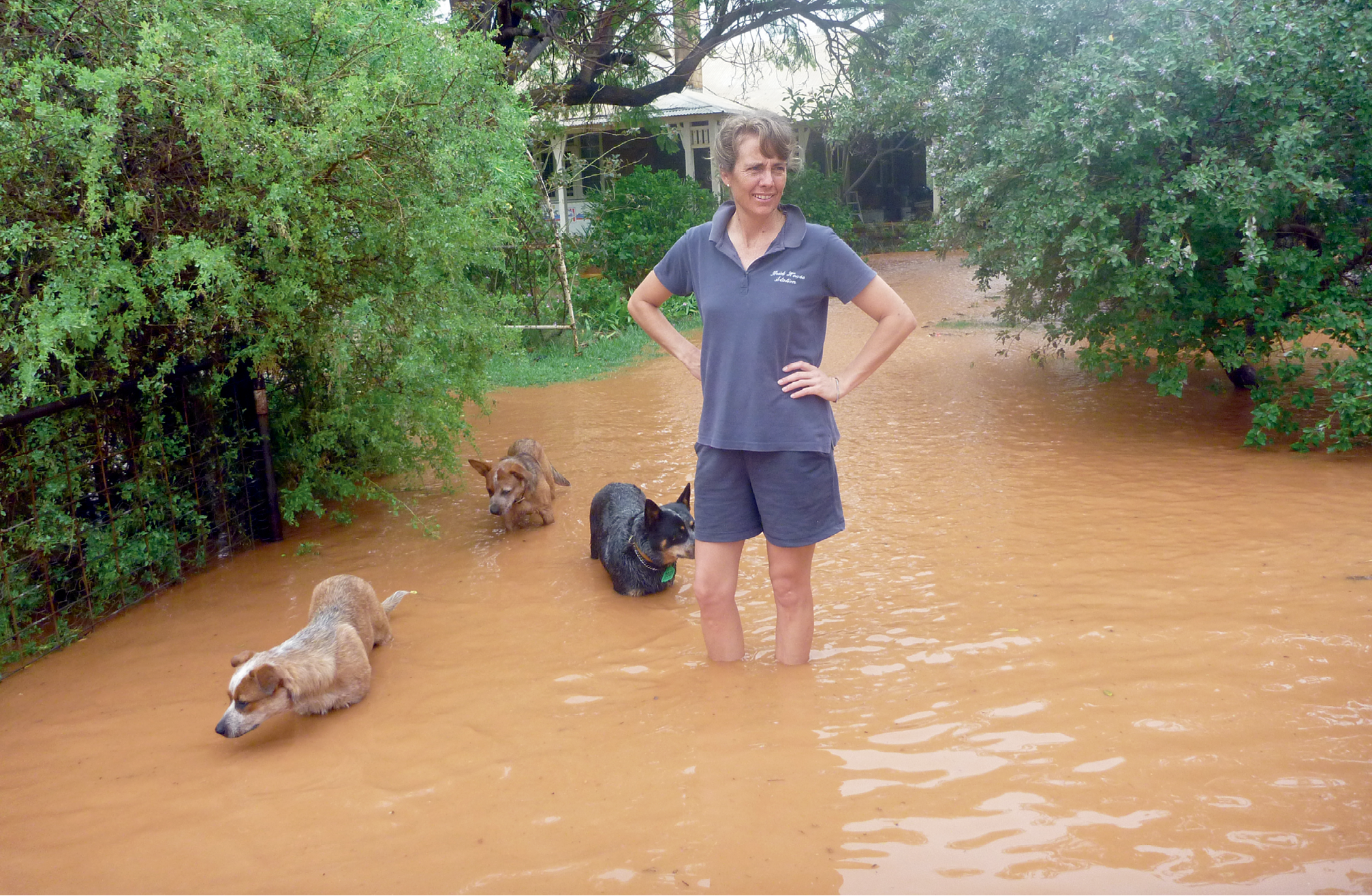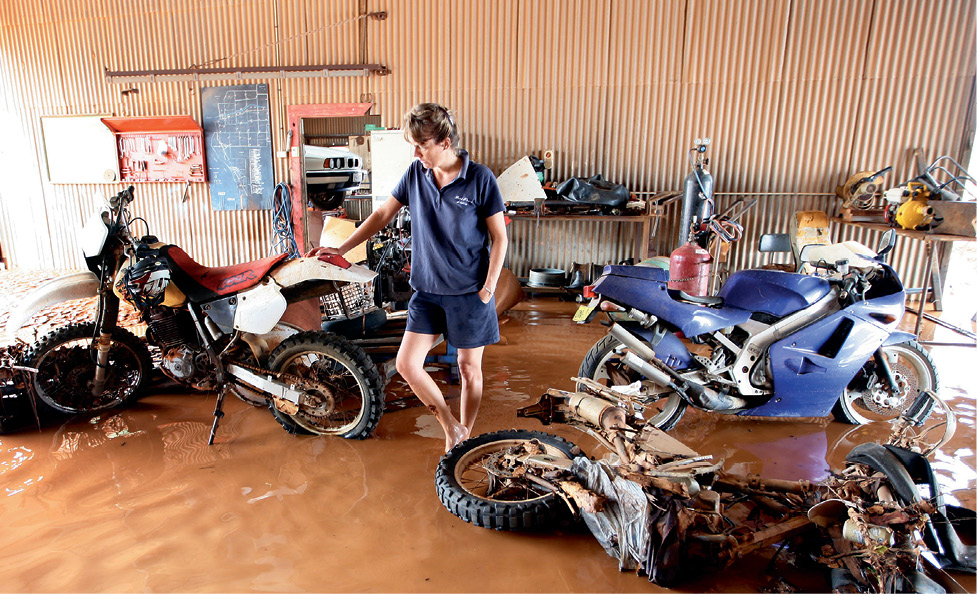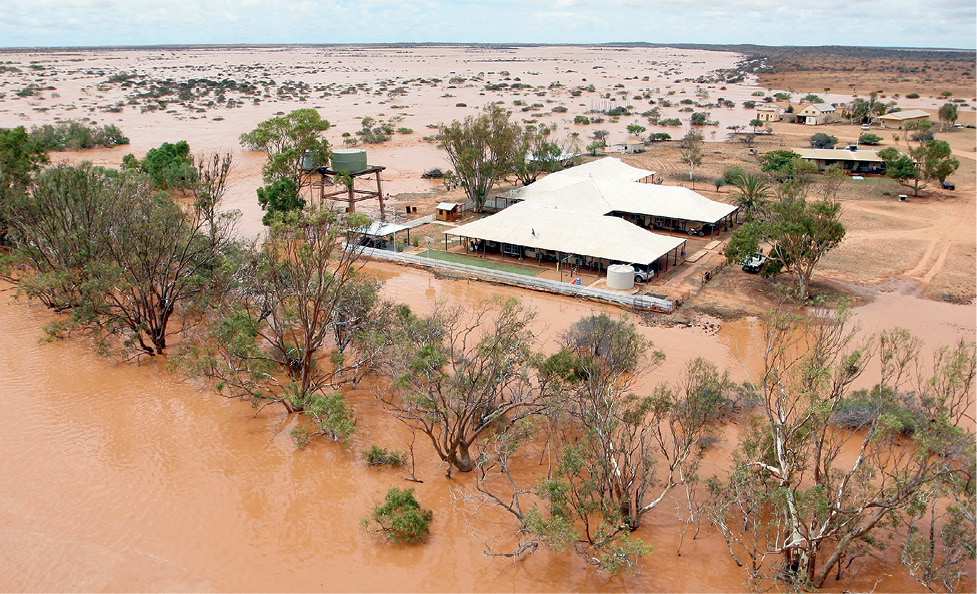
Rebecca Burt recounts her emotional roller-coaster ride of drought to flood in less than three months.
Rebecca Burt doesn’t shy from a challenge. A pilot and mother of two boys, she runs a cattle station with her husband Paull on the Gascoyne River, just outside the West Australian town of Carnarvon–where she is also a local councillor.
The Burts have a pastoral lease for 226,000 hectares and run 5000 head of cattle. Until the floods, they also had a few sheep.
Rebecca describes herself as strong and happy by nature. “It takes a lot to really flatten me,” she says.
When the entire station flooded in December, she and her family relished the excitement of it from the safety of their homestead’s verandah, surveying the lake that surrounded them. The boys, aged 10 and seven, steered their remote control boat all over what was once the front lawn. After a decade of drought, the Burts were just so grateful for rain.

But as the water receded, it revealed its destruction. Then, in the weeks and months that followed, Rebecca discovered the limits of her own strength.
In mid-December last year, Rebecca and Paull were aware the cyclone that been forecast for the area was no longer expected. “We were just praying to God it was going to hang around for some rain,” she says.
It did, and kept pouring as Rebecca and Paull went to bed on the Friday night, 17 December. A friend called to say a station up the road had received five inches in four hours. Rebecca thought little more of it.
“In the morning a staff member came in and had heard all the gossip in town saying: ‘there’s rain, there’s rain, the river’s coming down’,” she says. Rebecca and Paull decided to move their aeroplane, a Cessna 172, to Carnarvon, behind the levee. When they came home they began sandbagging their home, shifting vehicles and lifting as much as they could to higher ground.
Rebecca checked the Internet for water authorities’ predictions of the river height and was reassured.
About 2pm she checked again and realised they’d be in trouble. She got on her two-way radio and warned others in the area.
“Then we had to lift everything again,” she says. “So now I’ve gone into town and got more sandbags. We’ve started sandbagging and the rain started again, so we’re now sandbagging wet sandbags and we did that ‘til midnight.”
There was no time to protect the cottage where some of their staff lived—and they’d gone to Perth for the summer. The kitchen block is separate to the main house, and about a metre lower, so they shielded that. They were exhausted, and went to bed.
After a couple of hours, Rebecca woke and shone a torch on the front lawn, about 50 metres from the riverbank. The water was already there. She woke Paull and the two of them knew instantly they’d lost their workshop, on lower ground. All their fuel floated away.
“We just kept walking around, back to bed, grab another half an hour sleep, back up again,” Rebecca says.
“The kids were still asleep. It was quite warm, we’d left the door open. All our bedrooms go on to the verandah, so when the sun came up, we were just absolutely surrounded by water and the roar of the water was loud,” she says.
“I’ll be honest, the excitement was absolutely amazing, the kids were really excited, the whole thing was a big learning thing and it was great, until the aftermath.”
They sat on the verandah with the two-way radio and a mobile phone and listened to the ABC. Rebecca credits local ABC radio station (based in Karratha) with keeping her community together.
“They put it live to us down here so that anyone could ring in, talk to the guys up there, and they just wanted to know: How are you going? Is everything ok? Do you need anything? If you can’t get someone on the phone, call us, we’ll relay it. And then they kept saying ‘get on the Facebook page, we want to see photos,’ so the Facebook came out. So everyone got to see photos, everyone knew what everyone else was doing, so no one was in the dark. When you’re not in the dark, then the stress and the anxiety’s not there.”
But not everyone could call the ABC, the small town of Gascoyne Junction; about 180km from Carnarvon, has no mobile phone coverage.
“No phones, no radios, no power, no network. Nobody knows what’s going on, so everyone’s starting to think: are they still alive?” Rebecca says.
They were, but Rebecca believes people in that area may have received help sooner, had they had a mobile network.
The ABC invited psychologists on air, to explain what to expect.
“I didn’t believe it,” Rebecca says. “They said you get the adrenalin hangover then reality sets in, and don’t make any harsh decisions in the next three months. I thought, ‘yeah, yeah, right’.
“Well,” she laughs, in hindsight, “I have to agree with everything he said!”
For about three days, Rebecca ran on adrenalin, and barely slept. Soon she lost track of the days and crashed. “I couldn’t get out of bed,” she says.
Then again, the adrenalin returned. Roads were cut off by floodwater and people needed pilots. It took five days after the flood for the Burts to be able to land their plane on their airstrip. Rebecca then used it each day, for about three weeks, to fly into town and help a charter company take mining workers to and from a mine, and fly water to Gascoyne Junction.“About three weeks later, I think the worst of the reality hit,” Rebecca says.
“The ABC had lots of people coming on trying to discuss things, so I was fairly aware of it. Then they had a couple of counsellors in town that Paull and I did go and see, because at the end of the day when you have that much devastation, you think ‘where do you start?’ I couldn’t get out of bed in the morning, I thought ‘Why? What was the point?’
“By the time we needed to discuss it with somebody, I just cried. I couldn’t stop crying.”
This wasn’t the first time their workshop had flooded, but Rebecca says she simply didn’t know where to begin. There was no longer a driveway, the place was covered in mud, and the front-end loader was 50km away. They couldn’t get to it. The heat was also a problem.

Credit: The West Australian
Brickhouse Station owner Rebecca Burt looks over the destroyed work shed housing plane engines and now-ruined motorbikes.
“You’ve got to remember, it’s 40 degrees, and 98 per cent humidity, so anytime you started, you were wet,” Rebecca says.
“It became depressing. It was hard. I had family saying, ‘na, it’s too hot, I’m not going to come and give you a hand’. No one gave us a hand, we were here on our own. There were a lot of people who came in and had a sticky beak and left, but nobody would pick up a shovel."
“I felt like I’d been forgotten and it was very difficult.”
At the supermarket, Rebecca ran into a woman she knew from day care. She says the woman recognised immediately that she simply wasn’t herself.
The woman arranged for five other women from her local church to go with her to Brickhouse Station and help Rebecca.
“They came out and gave us a hand. That was the best thing they ever did,” Rebecca says.
“They cleaned out our singlemen’s quarters, then the next weekend they came and cleaned out another building and then they wanted to come the following weekend and I said no—we’d cleaned out two and a half buildings in two weekends and I couldn’t thank them enough. It got me over that hurdle.
“I’m not a church goer myself, I’m in God’s country, looking after his animals—but that’s where Carnarvon is a really good community,” she says.
It took until June for Rebecca and Paull to clean the last of their flooded buildings. They were grateful for the reprieve they received on their pastoral rent for six months, worth about $6,700.
They were insured but not for flood.

Credit: The West Australian
Brickhouse Station
“They won’t insure us for flood. The whole property is on a delta, everything went under, all 226,000 hectares,” Rebecca says.
Soon after the floods, Paull and Rebecca received help from Centrelink—$1000 each, and $400 per child. Paull said this money came quickly, and was easy to access—they visited a Centrelink office, filled in forms and the funds came through within days.
In January, the Commonwealth Government increased the financial help being offered to flood victims in the area, from $15,000 to $25,000, as a joint arrangement with the West Australian Government.
This money is being made available through clean-up and recovery grants of up to $5,000, not requiring proof of damage and expenditure, and grants of up to $20,000 for small businesses and primary producers, including pastoralists with proof of damage and expenditure.
The Burts say they have applied for both of these grants through the West Australian Government but were still waiting to receive them.
The biggest cost Paull Burt is now considering is the damage to the fencing that separates their cattle from Highway 1.
“A few of them have wandered onto the road but the majority are contained elsewhere,” Paull says.
The Burts didn’t lose a significant number, they’d shifted them away from the river.
“We just haven’t got the manpower or resources to go and fix 70km of fences,” he says.
He estimates that damage bill to be as high as $500,000.
One Saturday in June, Rebecca, went to the growers' market in town. There wasn’t much on offer. Crops are back in, but they’re not harvested yet. People are still coping with their own heartaches.
“Everyone still has their ups and downs,” Rebecca says. “Last week I had a big cry again. You go round the property and you still see the devastation.”
Before the floods, the Burts were trying to sell. They’d had enough. That’s now on hold, but after the floods, and with lower domestic beef prices, it seems more likely than ever.
“My dream is somewhere else now,” Rebecca says. “I want to carry on with my flying. I want to get into the airlines, and I’m so close.”
Kate Lahey is a senior journalist, commissioned by the Attorney-General's Department. Kate has been tasked with interviewing key Australian Government representatives and community members to share their stories on responding to the natural hazard events earlier this year. This July edition features the first three stories with more to come in future editions.